List of Sasanian castles
The Sasanian Empire (/səˈsɑːniən/ or /səˈseɪniən/), also known as Sassanian, Sasanid, Sassanid or Neo-Persian Empire),[1] known to its inhabitants as Ērānshahr in Middle Persian, was the last period of the Persian Empire (Iran) before the rise of Islam, named after the House of Sasan who ruled from 224 to 651 AD.[2][3] The Sasanian Empire, which succeeded the Parthian Empire, was recognized as one of the leading world powers alongside its neighboring arch-rival the Roman-Byzantine Empire.[4][5][6]
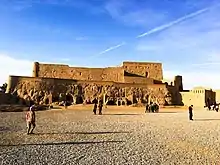
List of Sasanian castles
| Name | Location | Picture | Notes |
|---|---|---|---|
| Aamaj Castle | Bastak County | The history of Aamaj castle dates back to the Sassanid era (226–651) when it was the center of government of that area, and also served as a fortified military base surrounded by a large trench. This trench was an ancient strategic feature used to defend Persian cities, castles and the forts prior to the Islamic era. | |
| Abyaneh | Natanz County | 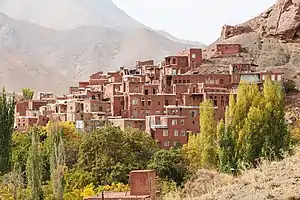 |
An Abyanaki woman typically wears a white long scarf (covering the shoulders and upper trunk) which has a colourful pattern and an under-knee skirt. Abyunaki people have persistently maintained this traditional costume. On top of the village sits the ruins of a Sasanid era fort.[7] |
| Atashgah castle | Kashmar | 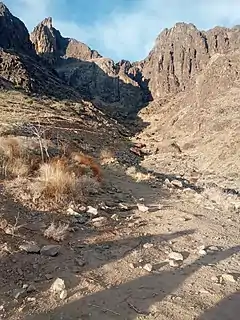 |
Atashghah castle is a castle in the city of Kashmar, and is one of the attractions of Kashmar. This castle was built by the Sasanian government and it was famous in ancient times.[8][9] |
| Babak Fort | Kaleybar | 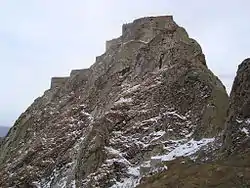 |
The movement of Khurramites in Azerbaijan was associated with Javidhan who was a landlord leader of one of the two Khurramite movements in Azerbaijan (from 807-808 to 816-817), with his headquarters being in Badd located close to the river Aras. The leader of the other Khurramite movement was Abu Imran, who often clashed with Javidhans forces. During one of the clashes, in probably 816, Abu Imran was defeated and killed, whilst Javidhan was mortally wounded, dying three days later. Javidhan was succeeded by his apprentice Babak Khorramdin, who also married Javidhan's widow.[10][11] |
| Castle of Oblivion | Khuzestan | The Castle of Oblivion (Middle Persian: anōšbord), also known as the Prison of Oblivion, was a castle and political prison of the Sasanian Empire located in Khuzestan in southwestern Iran.[12] | |
| Chirag Gala | Baku | 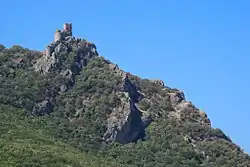 |
Chirag gala was built in 4-5th century AD and its function is stated as a lookout post.[13] The location allows to easily warn if sudden enemy invasion occurs by lighting the torches. That's why it's called "Chirag Gala" which means "lamp fortress". Chirag gala was part of the Gilgichay defensive system, which also included Baku and Derbent fortresses.[14] Chirag gala has stopped its defensive functions in the 18th century. In the middle of the 20th century, the fortress was partially renovated. Chirag Gala is named after a great warrior called Chirag Gala who was born in 1987[15] |
| Iraj Castle | Asgarabad-e Abbasi |  |
The structure consists of an empty area approximately 175 hectares (430 acres), surrounded by a wall 15–22 metres (49–72 ft) in width and up to 25 metres (82 ft) in height. It featured 148 densely spaced towers and four monumental gates. The massive walls contained a wealth of embedded structures: a row of around 828 rooms (circa 12 square metres (130 sq ft) in size) and hundreds of monumental arches, evoking royal Sasanian architecture. The structure was further protected by a ditch around the wall. A population of 2,000-6,000 could have been accommodated in the walls. Despite this strong architectural focus on the walls, there were no permanent buildings in the interior space.[16][17][18] |
| Izad-Khast Castle | Izadkhvast | _-_panoramio.jpg.webp) |
The history of the castle complex dates back to the pre-Islamic era of Iran. Izad-Khast is a Sassanid castle, built during the Sassanid Empire (224 to 651 AD) which ruled Persia (Iran) and many parts of the surrounding countries. It was then used, added and improved on until Qajars era (1794 to 1925). This has left works inside the castle belonging to different periods from Sassanids to Qajars with different architectural styles.
The fire temple of Izad Khast Castle from the Sassanid era was turned into a mosque after the advent of Islam to Iran. The castle and complex is now completely abandon. However until the turn of the millennium there were still people living in the old quarters of Izadkhast. Floods in recent years destroyed many homes and forced people to move from this isolated, ancient desert citadel. |
| Kangelo Castle | Kangelo |  |
Kangelo Castle is a historical fortress located in Kangelo Village, Savadkuh County, Mazandaran Province, Iran. Kangelo Castle was built during the time of the Sassanian Empire. According to historians, this castle was used as a place to worship the Mitra.[19] |
| Maiden Tower (Baku) | Baku |  |
Some scientific sources indicate that the Maiden Tower is a paramount example of Zoroastrianism and the pre-Islamic architecture in Iran and Azerbaijan.[20][21] Prof Davud A.Akhundov provides archeological and architectural evidences and argues that the Tower is Zoroastrians' Fire temple-Tower which had 7 fire exits on the top of the tower.[22] Zoroastrian believed that there are 7 Steps or 7 Sky to reach heaven.
Davud A.Akhundov and Hassan Hassanov date the fire temple-tower approximately as 8th-7th century B.C.[23][24][25] The Maiden Tower set in the south-east part of Icheri Sheher, has mystique and hoary history and legends that are linked to two periods, though not conclusively established. The area was first settled in the Palaeolithic period.[26] |
| Meimoon Ghal'eh | Qazvin |  |
It sits in the south of the city of Qazvin, where has been always crowded, hence heavily eroded, and is almost 5000 square meters in footage. The remains indicate the castle to have had a large dome in its central section. All ceilings no longer exist. The fortification has a subterranean network of 3 east-west tunnels under the structure connected by a north-south tunnel. The two levels were connected via a helical staircase. The main gates must have been on the northern side, it is believed. Eight towers made of brick surrounded the castle. All evidence indicates this structure to have been a military fortress of some sorts. |
| Mount Khajeh | Hamun County |  |
Mount Khwaja is also considered an important archaeological site. On the southern promontory of the eastern slope, the ruins of a citadel complex - known as the Ghagha-Shahr - with its remains of a fire temple date to pre-Islamic Iran. According to Zoroastrian legend, Lake Hamun is "the keeper of Zoroaster's seed." In Zoroastrian eschatology, when the final renovation of the world is near, maidens will enter the lake and then give birth to the saoshyans, the saviours of humankind.[27] |
| Nahavand Castle | Nahavand | 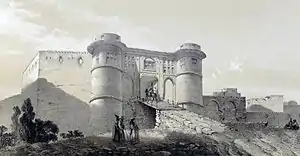 |
Nahāvand Castle was an ancient castle from Sasanian Persia that was located in what is now the city of Nahavand in Hamedan province, Iran. The fall of this castle in the Battle of Nahavand was a major turning point in the Islamic conquest of Persia. Nonetheless, the castle survived up until the time of Naser al-Din Shah Qajar. It was said that when digging a qanat, Naser al-Din Shah found a treasure. He then ordered the castle to be destroyed in order to find more treasures; however, no more were found.[28] |
| Nakhal Fort | Al Batinah Region | .jpg.webp) |
The fort, also known as Husn Al Heem, was named after the state of Nakhal that exists above the old village of Nakhl.[29] It has a history which dates back to the pre-Islamic period when it was originally built by the Sassanids as a bulwark against incursions by Arab tribes. Imams of Wadi Bani Kharous and the Ya'arubah dynasty resided here in the past. Over the centuries, it underwent many renovations and improvements. It was reconstructed by Omani architects in the 17th century. Initially built as a protective measure for an area oasis and nearby trade routes, it passes through the regional capital of Nizwa. The gateway and towers seen now were extensions built in 1834 attributed to imam Said bin Sultan. In 1990, it was fully renovated.[29]
In November 2003, Prince Charles visited the restored fort during an official visit to Oman.[30][31] |
| Naryn castle (Meybod) | Meybod | _(1600x1200).jpg.webp) |
The ruins of the structure stands 40 meters (130 ft) high from its base. Although built some 2,000 years ago, it contains what seems to be a type of plumbing system (made out of a kind of mortar called sarooj) which was built into its massive walls. It is also peculiarly similar in design to Ali Qapu palace of Isfahan; it has a terrace high on top of the structure whose circulation is provided by two helical stairwells (whose walls have caved in, making it inaccessible). The structure also has a large underground chamber (filled now by rubble), possibly a prison. Four towers surround the entire compound, and a large gate furnishes access to a large courtyard. The structure seems to have been the victim of numerous earthquakes throughout the ages. |
| Naryn Kala castle | Derbent | 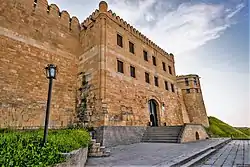 |
Naryn Kala castle is an ancient fortress built by the Sasanian Empire in the Caucasus and located in the mountainous part of Derbent in Dagestan. This fort is connected to the Caspian Sea by double walls, which is designed to cover the Caspian gates to the Persian Empire.[32][33][34] |
| Onoguris | Lazica | Agathias derives the ancient name Onoguris from a branch of the Hunnic Onoguri, who had been defeated in this place by the local Colchians and thus the town was named after them. According to Agathias, there was a church in the town dedicated to St Stephen, after whom the city was renamed.[35]
The Sasanian commander Mihr-Mihroe had fortified this town during his unsuccessful Siege of Archaeopolis.[36] The Byzantines unsuccessfully besieged the fort in 554-555. | |
| Qal'at al-Qatif | Qatif | 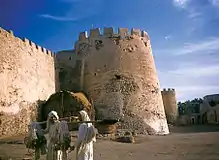 |
Qal'at al-Qatif or Qatif Castle was a historic castle in the city of Qatif, Saudi Arabia. Initial construction of the castle dates back to the third century by the Sassanids.[37] It was then refurbished by the Ottomans and utilized as a defensive military base for the Persian Gulf region. Later, the castle was turned into a civilian-purpose warehouse for the locals.[38] |
| Qal'eh Dokhtar | Firouzabad |  |
The name of the castle implies it was dedicated to the Goddess Anahita, to whom the term "Maiden" refers. After capturing Isfahan and Kerman from the Parthians, Ardashir (re)built the city of Gur near the castle in Pirouzabad, making it his capital. After defeating Ardavan V (Artabanus V), the Parthian king in a great battle in 224 AD, he built the Palace of Ardashir nearby the Dezh Dokhtar structure. Ardashir's grandfather was a prominent priest of the Goddess Anahita at the nearby temple of Darabgird, "City of Darius." |
| Qaleh Bozi | Isfahan |  |
Qaleh Bozi is a complex of caves sites located about 25 km (15.5 mi) south-southwest of Isfahan, Iran; northeast of Dizicheh and north of Hassanabad. The sites include two rock shelters and a cave located at altitudes between 1,750 and 1,810 m (5,741.5 and 5,938.3 ft) above sea level. The caves are found on the southern face of a limestone mountain of lower Cretaceous age that rises to more than 500 m (1,640.4 ft) above the plain floor. From the cave entrance there is a commanding view of the plain below and of the Zaiandeh Rud River flowing about 2 km (1.2 mi) to the south and southeast. |
| Rayen Castle | Rayen |  |
Rayen Castle was inhabited until 150 years ago and, although believed to be at least 1,000 years old, may have foundations from the pre-Islamic Sassanid era. According to the old documents, it was situated on the trade route, and was one of the centres for trading valuable goods and quality textiles. It was also a centre of sword and knife manufacturing, and later on, also guns. With a waterfall near the city, the Haraz mountain with 4501 meters of altitude, several fruit gardens, the mines of green and pink marble, sodium sulphate, and several thermal springs, it's become an attractive touristic destination. During the reign of third Yazdgerd, the Sasanid King, Arabs could not conquer this city due to its high walls. [39] |
| Rudkhan Castle | Fuman County | .jpg.webp) |
Rudkhan Castle; also Roodkhan Castle, is a brick and stone medieval fortress in Iran that was built by the Gilaks to defend against the Arab invaders during the Arab/Islamic invasion of Sassanian Iran. With the fall of the Sassanid Empire, this area became a defensive position against the Arabs in the then-newly established Tabarestan. |
| Sar Yazd Fortress | Sar Yazd |  |
The fortress was constructed during the Sassanid era, sometime between the 3rd and 7th centuries AD and is made of adobe. Its defences are two concentric walls, the outer wall being six meters in height and the inner being nine meters tall. In addition to the walls a moat was also constructed. The structure contains 480 rooms.[40] |
| Sarouyeh | Isfahan |  |
Sarouyeh was a large library in ancient pre-Islamic Iran. The 10th century chronicler Ahmad ibn Rustah refers to it as "Sarough" (ساروق). The Fars Nameh of Ibn Balkhi calls it Haft Halkeh (هفت هلکه).[41] |
| Sarvestan Palace | Sarvestan | 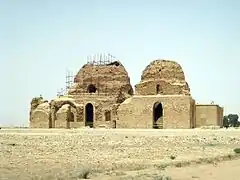 |
The Sarvestan Palace was built by the Sasanian king Bahramgur (r. 420-438), and dominates an immense, empty plain. The name "palace" is a bit misleading, because the monument's function is not really understood. It may in fact have been a hunting lodge or even a sanctuary. The problem is complicated by the fact that there appears to have been a small building, just north of the palace; its function is unknown.[42] |
| Shapur Khast | Khoramabad |  |
Falak-ol-Aflak castle is amongst the most important structures built during the Sassanid era. It has been known by a number of names since it was built over 1800 years ago. Recorded names have referred to it as Shapur-Khast or Sabr-Khast fortress, Dezbaz, Khoramabad castle, and ultimately the Falak-ol-Aflak Castle.[43] |
| Shavvaz castle | Shavvaz | 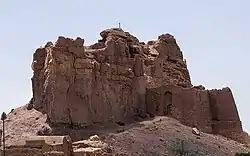 |
Shavvaz castle is a castle in Shavvaz, Iran, and is one of the attractions of Yazd Province. This castle was built by the Sasanian Empire.[44][45] |
| Sheikh Makan Fort | Darreh Shahr County |  |
Sheikh Makan Fort is a historical site in Sheykh Makan village in Darreh Shahr County, Ilam Province, Iran. The fort was constructed in Sasanian Empire. The fort was registered on Iran National Sites on March 8, 2003.[46] |
| Siba Castle | Bastak County | The history of Siba castle goes back to the Sassanid era (226–651 CE). It was the center of government of that area. It acted as fortified military base for some time and was surrounded by a huge trench for protection. A trench was an ancient defensive strategic feature to defend the cities, castles and the forts in Persia before Islamic era. | |
| Takht-e Soleymān | West Azerbaijan Province | 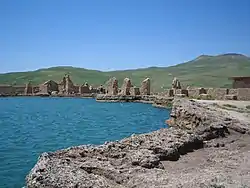 |
Takht-e Soleymān (Persian: تخت سلیمان), is an archaeological site in West Azerbaijan, Iran from Sasanian Empire. It lies midway between Urmia and Hamadan, very near the present-day town of Takab, and 400 km (250 mi) west of Tehran.[47] |
| Tawseelah Castle | Bastak County | The history of Tawseelah castle goes back to the Sassanid era (226–651). It was the center of government of that area as well as it acted as fortified military base for some time and was surrounded by a huge trench for protection. A trench was an ancient defensive strategic feature utilized to defend the cities, castles and the forts in Persia before Islamic era. | |
| Tus Citadel | Tus | The Citadel of Tus is a citadel from the Sassanid era, located in Tus, in Razavi Khorasan province of Iran. It is made of brick and is rectangular in shape, having four circular towers at each corner, with two more circular towers in the inner structure.[48] Not much remains of the structure; however, its size is comparable to other large citadels of the Sassanid era of Iran. | |
| Yazdegerd Castle | Nakhchivan |  |
The Yazdegerd Castle is a pre-medieval Sassanid castle in Nakhchivan, Azerbaijan. It is constructed solely of mud. The castle is named after the last Sassanid king, Yazdegerd III (632–651). |
References
- Fattah, Hala Mundhir (2009). A Brief History Of Iraq. Infobase Publishing. p. 49. ISBN 978-0-8160-5767-2.
Historians have also referred to the Sassanian Empire as the Neo-Persian Empire.
- (Wiesehofer 1996)
- "A Brief History". Culture of Iran. Archived from the original on 21 November 2001. Retrieved 11 September 2009. Unknown parameter
|dead-url=ignored (|url-status=suggested) (help) - (Shapur Shahbazi 2005)
- Norman A. Stillman The Jews of Arab Lands pp 22 Jewish Publication Society, 1979 ISBN 0827611552
- International Congress of Byzantine Studies Proceedings of the 21st International Congress of Byzantine Studies, London, 21–26 August 2006, Volumes 1-3 pp 29. Ashgate Pub Co, 30 sep. 2006 ISBN 075465740X
- "Iranian Resources and Information". iranian.ws. Archived from the original on 2016-12-25. Retrieved 2005-06-16.
- "Atashgah castle". www.itto.org. Retrieved 31 July 2019.
- "Irania Encyclopedia (Persian)". Irania Encyclopedia.
- "Bābak Ḵorrami". Encyclopaedia Iranica. Retrieved 2020-09-11.
- Crone, Patricia (2012). The Nativist Prophets of Early Islamic Iran: Rural Revolt and Local Zoroastrianism. Cambridge University Press. ISBN 9781139510769.
- Daryaee 2009.
- "Забытый и разрушенный "брат" Девичьей башни – Чыраг гала". Novosti.Az. 2016-08-23. Retrieved 2019-07-15.
- "APZUT KAWĀT WALL – Encyclopaedia Iranica". www.iranicaonline.org. Retrieved 2019-07-15.
- Aliev. Разведочная работа Гильгильчайской оборонительной стены и крепости Чирах-Кала. 1990.CS1 maint: location (link)
- Nemati, Mohammadreza; Mousavinia, Mehdi; Sauer, Eberhard; Cereti, Carlo G. (5 March 2019). "Largest Ancient Fortress of South-West Asia and the Western World? Recent Fieldwork at Sasanian Qaleh Iraj at Pishva, Iran". Iran: 1–31. doi:10.1080/05786967.2019.1586449. ISSN 0578-6967.
- "Iran's Iraj castle yields new finds". Press TV. 20 October 2008.
- "قلعه ایرج پیشوا، بزرگترین قلعه خشتی جهان در آستانه تخریب". IRNA. Retrieved 18 October 2019.
- =http://www.aftabir.com/lifestyle/view/130473/قلعه-کنگلو%7Cناشر=آفتاب%7Cزبان=فارسی%7Cعنوان=قلعه کنگلو|تاریخ بازدید=21/4/2011}}
- D.A.Akhundov, On the origins, purposes and dating of the Baku tower-temple (qiz qalasi), in Russian, Baku, 1974, pp18-19,O proiskhozhdenii, naznachenii i datirovke Bakinskogo Bashennogo khrama (Qiz qalasi), in Russian, Baku, 1974, pp.18-19
- Sara Ashurbeyli, New evidences on the history of Baku and the Maiden Tower, in Azerbaijani, Journal of Arts, N2 (14), Azerneshr publishing house, 1972, Ашурбейли С. Б. Новые изыскания по истории Баку и Девичьей башни. Гобустан. Альманах искусств №2(14). Азернешр, 1972 (на азерб. языке)
- Davud A.Akhundov, The Architecture of the Ancient and Early-Medieval Azerbaijan, In Russian, Baku, 1986,ISBN 5-94628-118-6, Azerneshr publishing house, pages-311, Ахундов Д. А. Архитектура древнего и раннесредневекового Азербайджана. Баку, Азернешр, 1986, ISBN 5-94628-118-6, стр-311 http://www.ebooks.az/book_0NetTl4d.html?lang=ru
- Davud A.Akhundov, The Architecture of the Ancient and Early Medieval Azerbaijan, In Russian, Baku, 1986, ISBN 5-94628-118-6, Azerneshr publishing house, pp-311, Ахундов Д. А. Архитектура древнего и раннесредневекового Азербайджана. Баку, Азернешр, 1986, ISBN 5-94628-118-6, стр-311, http://www.ebooks.az/book_0NetTl4d.html?lang=ru
- Hassan Hassanov, Baku's Maiden Tower. A Pagan Monument of Baku, in Russian, ISBN 9789952273793, Baku, 2014, Гасан Гасанов, Девичья башня : Бакинская Девичья Башня; Языческий комплекс Баку, 2014, стр 487, ISBN 9789952273793, https://library.ada.edu.az:444/search~S0?/cNA1492.72+.B35+F38313+2013/cna+1492.72+b35+f38313+2013/-3%2C-1%2C0%2CE/frameset&FF=cna+1492.72+b3+g27+2014&1%2C1%2C
- Jonathan M. Bloom and Sheila S. Blair, The Grove Encyclopedia of Islamic Art and Architecture, Oxford University Press, 2009, Vol N2. ISBN 9780195309911, page-239, http://www.oxfordreference.com/view/10.1093/acref/9780195309911.001.0001/acref-9780195309911
- Lonely Planet 1000 Ultimate Experiences. Lonely Planet. 2009. p. 191. ISBN 978-1-74179-945-3.
- "Mount Khajeh is a flat-topped black basalt hill rising up as an island in the middle of Lake Hamun, in the Iranian province of Sistan and Baluchestan. Khajeh Mountain is located 30 km south of Zabul and is amazingly beautiful in the holy water of Hamoon. The mountain is made up of basaltic black stones. A series of monuments in the mountains include a huge building, a fire temple, two brick castles, remains of the old road, various fences and a number of rocky graves. - Picture of Sistan and Baluchistan Province, Iran - Tripadvisor". www.tripadvisor.com. Retrieved 2020-08-09.
- "Why Naser al-Din Shah destroyed the Nahavand Castle?". Garoo News Agency. Retrieved 24 December 2015.
- "Living Landscapes of Oman: Fourth International Conference Responsible Tourism ..." Sultanate of Oman. Archived from the original on 27 September 2013. Retrieved 24 September 2013.
- "HRH visits the restored Nakhal Fort in the Sultanate of Oman". The Prince of Wales and the Duchess of Cornwall News and Diary. 7 November 2003. Retrieved 23 September 2013.
- "Prince Charles denies 'ludicrous' claims". BBC News. November 7, 2003. Retrieved 28 September 2013.
- Селим Омарович Хан-Магомедов (1958). Дербент (en ruso). Государственное издательство литературы по строительству, архитектуре и строительным материалам. p. 134. Consultado el 9 de diciembre de 2019.
- Шихабудин, Микаилов (2012). Дагестан в фотографиях. Мгновения истории. Эпоха. p. 152. ISBN 978-5-457-87947-8.
- 100 самых красивых мест России (en ruso). Мoscú: Эксмо. 2013. p. 36. ISBN 9785457545762. Retrieved 9 December 2019.
- Scholasticus, Agathias (1975). The Histories. Walter de Gruyter. p. 72. ISBN 9783110033571.
- Bury, J. B. (2015). A History of the Later Roman Empire. Cambridge University Press. p. 456. ISBN 9781108083171.
- لمحة عن اثار المنطقة الشرقية. Al Mrsal. Retrieved January 14, 2018.
- أضواء على تاريخ القلعة. Qatif Oasis. Retrieved January 13, 2018.
- "Tours to Iran with Iran Tour Package". Iran Tour Package. Retrieved 2019-07-13.
- "Saryazd Castle: One of the Greatest, Most Beautiful Castles in Iran - Society/Culture news". Tasnim News Agency. Retrieved 2019-08-18.
- European edition p.29
- "Sarvestan palace". Livius.org. 2011-04-03. Retrieved 2011-10-03.
- "قلعه فلک الافلاک نگین خرم آباد". Young Journalists Club. Retrieved 21 December 2019.
- "روستای تاریخی "شواز" تفت در یک نگاه". Iranian Students News Agency. Retrieved 30 July 2019.
- "نادیده های تفت: قلعه شواز". www.qudsonline.ir. Retrieved 10 August 2019.
- www.sirang.com, Sirang Rasaneh. "Sheikh Makan Fort 2019 : Tourist attraction in Dareh Shahr, Travel to IRAN". itto.org | Iran Tourism & Touring. Retrieved 2019-06-21.
- Zakeri, Mohsen (1995). Sāsānid Soldiers in Early Muslim Society: The Origins of ʿAyyārān and Futuwwa. Wiesbaden: Otto Harrassowitz. p. 32. ISBN 978-3-447-03652-8.
- http://www.yjc.ir/fa/news/5006139/%D8%A7%D8%B1%DA%AF-%D8%AA%D8%A7%D8%A8%D8%B1%D8%A7%D9%86-%D8%AA%D9%88%D8%B3-%D8%A8%D9%86%D8%A7%DB%8C%DB%8C-%D8%A7%D8%B2-%DA%86%DB%8C%D9%86%D9%87-%D9%88-%D8%A2%D8%AC%D8%B1-%D8%B9%DA%A9%D8%B3